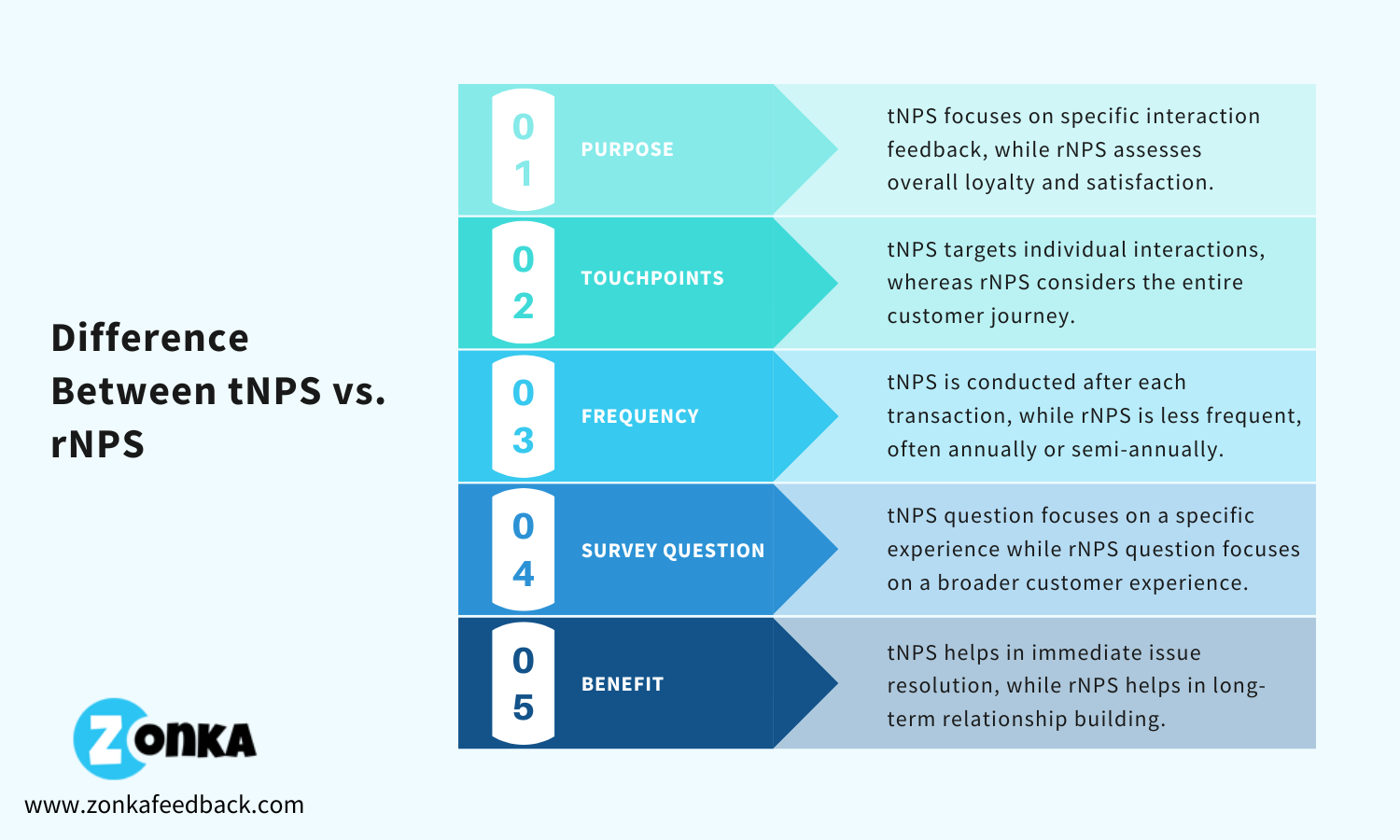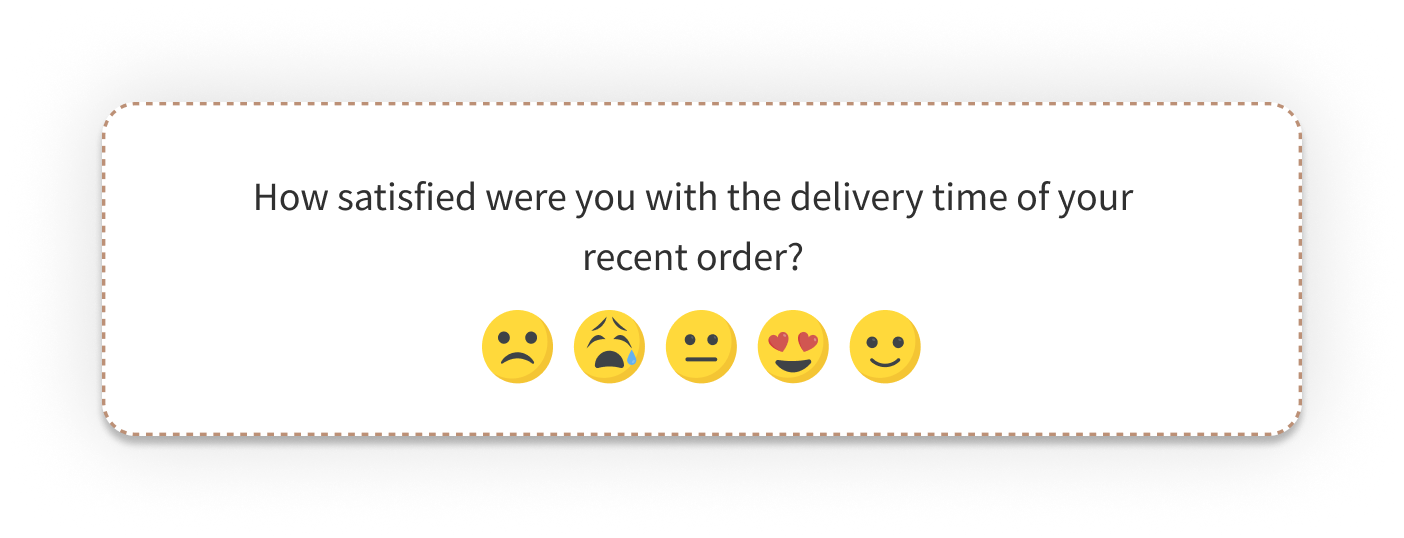The easiest way to define customer experience is the way your customers view the nature of their relationship with your company. Providing your customers with delightful experiences is the cornerstone of building strong, lasting customer relationships.
Net Promoter Score helps you quantify this delight and understand the factors driving customer loyalty with just one powerful question: "How likely are you to recommend (product/service) to a friend or colleague?" on a scale of 0 (not at all likely) to 10 (extremely likely).
But a key element of NPS effectiveness lies in the survey type. Do you use relationship surveys to gauge overall brand loyalty, or transactional surveys to focus on specific interactions?
Each type of NPS survey has its own important role to play in your business growth. But how would you know which one to use and when?
In this blog, we will explore the difference between transactional NPS and relational NPS, their use cases and determine the most suitable approach for gaining actionable insights in different scenarios.
TL;DR
-
Transactional NPS survey focuses on specific interactions to improve the customer journey while relational NPS surveys assess overall loyalty and satisfaction.
-
tNPS surveys can be used to get customer service feedback, new business interactions, or important product feedback while rNPS surveys can be used to assess brand perception and customer loyalty over time.
-
While transactional surveys target immediate improvements, relational surveys provide insights for long-term strategies, helping businesses enhance customer loyalty.
-
Choosing between transactional and relational NPS surveys depends on the need for immediate feedback versus long-term insights, aligned with your resource capacity and strategic goals.
-
By utilizing an NPS survey tool like Zonka Feedback, you can easily create surveys, collect both quantitative and qualitative feedback, and analyze survey results to take action and close feedback loop. Sign up for a free trial or schedule a demo to get started with creating NPS surveys!
Measure Customer Loyalty with NPS ❤️
Create NPS surveys, measure customer loyalty, and close the feedback loop with Zonka Feedback.

What are Transactional NPS (TNPS) Surveys?
Transactional NPS surveys provide a straightforward way to collect customer feedback by capturing opinions shortly after customers engage with your product, service, or a particular department. This targeted approach helps improve different aspects of the customer journey.
For instance, let's say you run an e-commerce website. After a customer completes a purchase, you can send them a transactional NPS survey to gather feedback on their shopping experience. The survey can inquire about their overall satisfaction with the purchase process, the ease of finding products on your website, the checkout experience, the speed of delivery, and their likelihood to recommend your brand.

Such NPS feedback can help you understand the immediate impact of specific interactions on customer loyalty and improve customer experience at every touchpoint.
Where to Use Transactional NPS Survey?
Taking feedback from customers after specific interactions will enable you to comprehend what the reason for their assessment was after a particular experience. Here are some touch-points where a transactional survey can be used:
a. Use Transactional NPS to Get Post-Service Feedback
Send your customer a Transactional NPS Question to understand whether the customer service agent was able to resolve customer's issue. Due to the high volume of customer service requests, responses can be overlooked or solutions may not be effective. Connecting with customers post-service helps gauge satisfaction and improve the process if needed.
b. Use Transactional Net Promoter Score Surveys after New Business Interaction
Asking your customers how satisfied they are with your service after a new transaction is critical since such interactions can be associated with issues like payment problems or shipping errors.
By using NPS software to create a transactional survey in this specific situation, the data collected will provide insight into possible solutions and help in improving the process in the long run.
c. Use Transactional NPS Surveys to Get Feedback After an Important Product Update
Asking for customer feedback after a major product update can spare you from potential blunders, highlight successful interactions, and suggest improvements. If you wish to understand audience reaction to a new product, creating a transactional survey with a Product NPS Survey Template will do wonders.
What are Relationship NPS Surveys?
Relational NPS feedback helps assess the general sentiment towards your brand or organization, indicating the overall satisfaction and loyalty of your customers. This measurement is valuable for monitoring your brand's health and tracking any trends or changes over time and gauging customer loyalty.
For example, when you conduct yearly customer surveys to identify customer's experience and satisfaction, you can use relational Net Promoter Score (NPS) surveys. These NPS surveys don’t depend on specific customer transactions but reflect customers’ overall feelings and opinions toward your brand.

Where to Use Relational NPS Surveys?
Here are some examples of where you can use relational NPS surveys:
a. Use Relational NPS Survey to Conduct Annual Customer Surveys
Relational NPS surveys are ideal for conducting annual customer surveys to gauge overall satisfaction and measure customer loyalty. These surveys can help you track changes in customer sentiment over time, promote customer engagement, and identify areas where improvements are needed.
b. Use Relationship NPS for Brand Perception Studies
You can use relational NPS surveys to conduct brand perception studies and understand how customers perceive your brand. These surveys can provide valuable insights into your brand's strengths and weaknesses, helping you make informed decisions about your marketing strategies.
c. Use Relationship NPS to Gauge Employee Engagement
Relational NPS surveys are effective tools for evaluating employee satisfaction and engagement levels within your organization. Engaged employees are more inclined to deliver exceptional customer service, ultimately enhancing overall customer satisfaction and loyalty. This proactive approach can strengthen your workforce and also contribute to a more positive customer experience.
Differences Between Transactional NPS Survey vs Relationship NPS Survey
To clearly understand the distinction between transactional NPS and relationship NPS surveys, let's explore their key differences so that you can create a seamless customer experience.

1. Purpose
Transactional NPS surveys collect feedback on specific interactions or transactions, like a hotel asking about a guest's stay. This helps address immediate issues, such as room cleanliness.
Relationship NPS surveys assess overall customer loyalty and satisfaction across multiple interactions. For example, an airline may gauge how likely frequent flyers are to recommend the airline, influencing long-term strategies.
2. Touchpoints
Transactional NPS surveys target specific touchpoints or interactions, such as a purchase or customer service call, or a visit to a physical store. By gathering feedback at these specific touchpoints, businesses can identify areas for improvement and enhance the overall customer experience.
Relationship NPS surveys consider the entire customer journey, looking at multiple touchpoints over time. For instance, an online subscription service might measure customer satisfaction to get an overall understanding of how likely customers are to continue using the service.
3. Frequency
Transactional NPS surveys can be conducted after each business transaction or interaction, allowing for frequent feedback collection.
On the contrary, relationship NPS surveys are typically conducted less frequently, such as annually or semi-annually, providing a long-term view of customer sentiment.
4. Survey Questions
The survey question for the transactional NPS surveys would focus on specific interactions or transactions that a customer has had with a business. These NPS survey questions are designed to gather feedback on the quality of that particular interaction and how it has influenced the customer's likelihood to recommend the business to others.
Here are some transactional NPS survey questions examples:
-
How satisfied were you with your recent interaction with our customer service team?
-
How likely are you to recommend our store/location to a friend or colleague based on your recent visit?

On the contrary, relational NPS surveys include questions that assess the overall relationship between a customer and a business. These survey questions focus on the broader customer experience and aim to identify trends and patterns in customer sentiment that can inform long-term strategies for improving customer satisfaction and loyalty.
Here are a few examples of rNPS survey questions:
-
How satisfied are you with your overall experience with our brand?
-
On a scale of 0-10, how likely are you to recommend our product based on its pricing and the perceived value it offers?
5. Customer Journey
tNPS survey focuses on individual touchpoints within the customer journey, providing insights into the quality of each interaction. For instance, a pizza delivery service might use a transactional NPS survey to collect feedback after a delivery, asking about the delivery experience. This helps the service understand if the pizza arrived hot and on time, and if the delivery person was friendly.
Relationship NPS surveys consider the entire customer lifecycle journey, helping to identify trends and patterns in customer satisfaction and loyalty over time. For example, a gym might use a relationship NPS survey to assess overall satisfaction a few months after a member signs up, asking about their likelihood to recommend the gym to a friend. This helps the gym track changes in customer satisfaction and identify areas for improvement across the entire membership experience.
6. Benefits
Transactional NPS surveys help in identifying and addressing immediate customer pain points, leading to improved customer satisfaction. For example, an online retailer might use post purchase surveys as a transactional NPS survey to address issues with product quality or delivery speed.
Relationship NPS surveys provide a holistic view of customer loyalty and satisfaction, aiding in long-term relationship building and brand growth. For example, a subscription-based service might use valuable feedback from a relationship NPS survey to refine its marketing strategies and improve customer retention.
Transactional NPS Surveys or Relationship NPS Surveys?
Choosing between transactional NPS surveys and relational NPS surveys depends on your specific goals and the nature of your interactions with customers.
When deciding between the two, consider the following factors:
-
Type of Customer Feedback Needed: If you require feedback on a specific interaction or transaction to make immediate improvements, transactional NPS is the way to go. However, if you seek a deeper understanding of overall customer sentiment and loyalty over time, relational NPS provides a broader perspective.
-
Survey Goals: Determine whether your focus is on improving specific points in the customer journey for which you can send transactional NPS surveys or on enhancing overall customer satisfaction for which relational NPS is suitable.
-
Frequency of Interaction: Consider how often customers interact with your business. If interactions are frequent and varied, transactional NPS surveys can pinpoint areas for improvement at each touchpoint. Conversely, if interactions are less frequent but long-lasting, relational NPS surveys can track changes in sentiment over time.
-
Strategic Focus: Transactional NPS surveys are ideal for tactical, short-term decisions, allowing you to quickly address specific issues. On the other hand, relational NPS surveys are more strategic, providing insights for long-term planning and customer relationship management.
-
Resource Allocation: Evaluate your resources for survey administration and analysis. Transactional NPS surveys may require more immediate attention and resources due to their continuous nature, whereas relational NPS surveys are less frequent and may be more manageable with fewer resources.
Conclusion
Understanding the differences between transactional and relationship NPS surveys is crucial for businesses looking to match customer expectations and enhance their customer experience strategies. Transactional NPS surveys target specific interactions for immediate feedback, while NPS relationship survey provides a long-term view of loyalty and satisfaction.
When choosing between transactional and relational NPS surveys, consider your specific goals, the frequency of customer interactions, and the resources available for survey administration and analysis.
By selecting the right NPS survey tool for your business, you can gather valuable insights, improve customer satisfaction, and drive long-term growth.
Zonka Feedback is one such survey tool that can help you analyze transactional NPS data and relational survey data and measure customer satisfaction and loyalty. With features like customizable survey templates, user segmentation, workflow automation, sentiment analysis, and real-time reporting and analytics, you can easily create and manage surveys tailored to your specific needs.
Sign up for a 14-day free trial and get started with measuring and improving customer satisfaction and loyalty with various NPS survey types.











